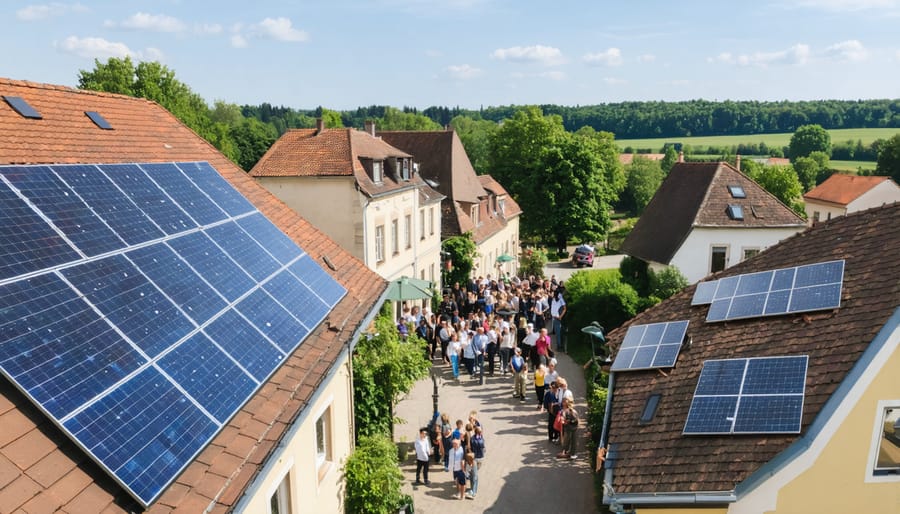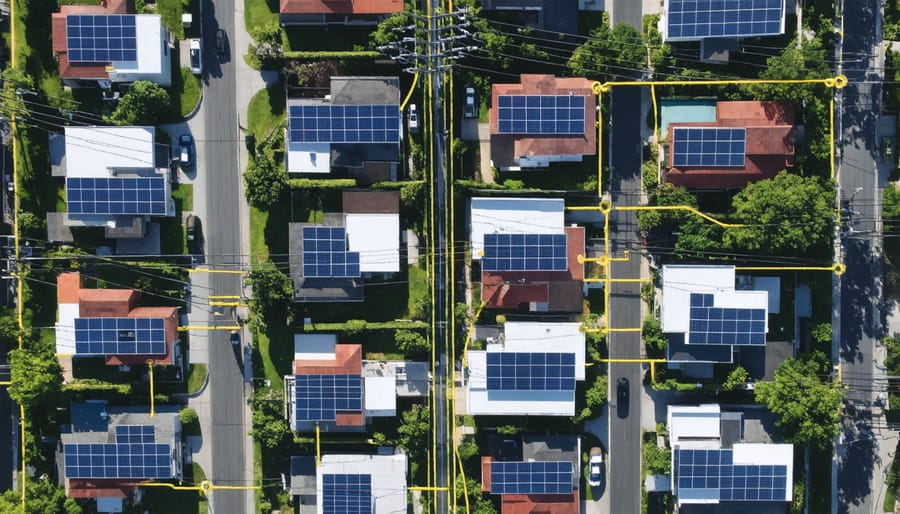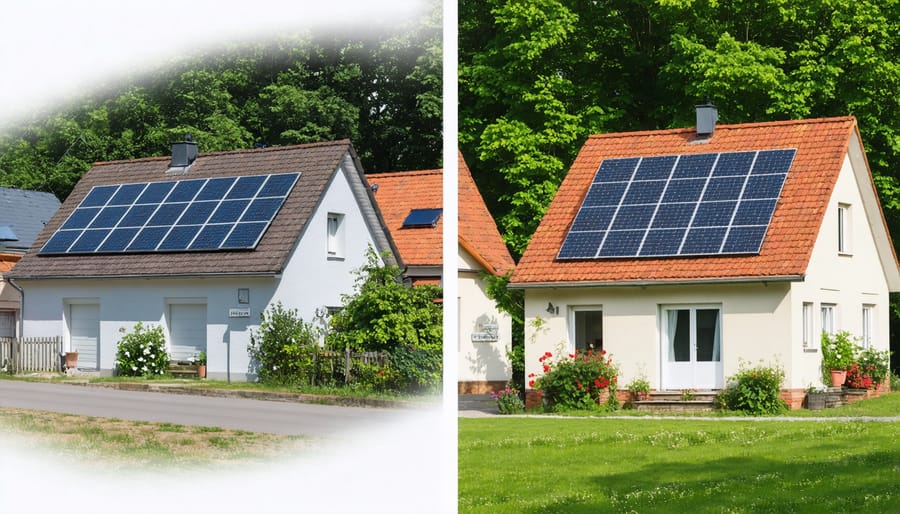How Solar Communities Are Revolutionizing Europe’s Energy Future

Community-based transition programs revolutionize how European neighborhoods approach sustainable energy adoption through structured, locally-driven initiatives. These community solar initiatives transform individual sustainability efforts into powerful collective action, delivering measurable environmental and economic benefits across participating regions.
By integrating local governance, technical expertise, and citizen participation, these programs create resilient frameworks for implementing renewable energy solutions at scale. Leading European municipalities have demonstrated that well-structured transition programs can reduce energy costs by 30-40% while strengthening social cohesion and environmental stewardship.
The most successful community-based transitions combine three essential elements: transparent stakeholder engagement, phased implementation strategies, and sustainable financing mechanisms. This comprehensive approach ensures long-term viability while maximizing community benefits through shared resources, reduced costs, and enhanced energy independence.
For communities considering such programs, the potential extends beyond environmental impact. These initiatives create local jobs, stimulate regional economic growth, and establish replicable models for sustainable development across Europe’s diverse urban and rural landscapes.
Building Solar Communities from the Ground Up
Collective Planning and Decision Making
Successful community-based solar transitions rely on structured collective planning and inclusive decision-making processes. Communities typically begin by forming dedicated steering committees that represent diverse stakeholders, including residents, local businesses, and municipal authorities. These committees establish clear objectives and timeline frameworks while ensuring transparent communication channels for all participants.
The planning process often involves regular community meetings where members can voice concerns, share ideas, and participate in key decisions. Many European communities utilize digital platforms and collaborative tools to facilitate broader participation and streamline the decision-making process. This approach has proven particularly effective in regions like Denmark and Germany, where community energy projects have flourished through collective organization.
To maintain momentum and ensure project success, communities often create working groups focused on specific aspects such as technical implementation, funding coordination, and public engagement. These groups regularly report back to the broader community, allowing for continuous feedback and adaptation of plans as needed. The most successful transitions incorporate regular milestone reviews and maintain flexibility to address emerging challenges or opportunities while keeping the community’s original goals in focus.
Shared Infrastructure Development
Community solar installations form the backbone of successful transition programs, integrating renewable energy infrastructure with existing power grids. These shared facilities typically include large-scale solar arrays strategically positioned to maximize energy generation while minimizing environmental impact. Modern installations incorporate smart grid technologies, enabling efficient distribution and real-time monitoring of energy production and consumption patterns.
The development process involves careful planning of grid connection points, installation of advanced inverter systems, and implementation of energy management solutions. Many European communities have successfully integrated battery storage systems to enhance grid stability and maximize the utilization of solar-generated power during peak demand periods.
Infrastructure development also encompasses the creation of monitoring and control centers, allowing communities to track energy production, manage distribution, and ensure system reliability. These facilities often feature educational components, such as visitor centers and real-time displays, promoting community engagement and understanding of renewable energy systems.
Local authorities and energy cooperatives typically collaborate on permit processes, grid connection agreements, and maintenance protocols, ensuring long-term sustainability of the shared infrastructure. This collaborative approach has proven particularly successful in regions like Germany and Denmark, where community energy projects have become integral to the national energy transition strategy.


Financial Models That Power Community Solar
Group Purchase Programs
Group purchasing programs represent a powerful strategy within community-based transition initiatives, enabling neighborhoods and local organizations to maximize their collective buying power. By aggregating demand for solar installations, communities can negotiate better prices and secure more favorable solar project funding mechanisms than individual purchasers might achieve alone.
These programs typically operate through a coordinated procurement process, where community organizers gather interested participants and engage with multiple suppliers. The resulting economies of scale often translate into savings of 15-25% on installation costs, making renewable energy more accessible to a broader segment of the population.
In European contexts, successful group purchase initiatives have demonstrated remarkable results. For instance, the Solar Together program in London has helped thousands of households access quality solar installations at reduced costs, while similar initiatives in Germany and the Netherlands have accelerated local energy transitions through collective action.
The process usually involves several key steps: initial community outreach, participant registration, bulk tender to qualified suppliers, competitive bidding, and coordinated installation scheduling. This structured approach ensures quality control while maximizing cost efficiencies. Additionally, many programs incorporate educational components and technical support, helping participants make informed decisions about their solar investments.
Energy Cooperatives
Energy cooperatives represent a powerful model for community-driven renewable energy transitions, particularly in the solar sector. These democratically-controlled organizations enable local citizens to collectively own and manage renewable energy projects, fostering both environmental sustainability and economic benefits for their members.
In a typical community solar cooperative, members pool their resources to invest in larger-scale solar installations. These projects can range from rooftop arrays on community buildings to ground-mounted solar farms on shared land. The cooperative structure ensures that profits and benefits flow directly back to community members, rather than external investors.
The advantages of energy cooperatives extend beyond financial returns. Members gain direct control over their energy production, reduce their carbon footprint, and contribute to local energy independence. Many European cooperatives also reinvest surplus funds into additional sustainability projects or community initiatives, creating a positive cycle of local development.
Notable success stories include Germany’s numerous Energiegenossenschaften, which have pioneered the cooperative energy model, and Denmark’s wind energy cooperatives, which have since expanded into solar projects. These examples demonstrate how community ownership can accelerate the transition to renewable energy while maintaining strong local support and engagement.
To establish an energy cooperative, communities typically follow a structured process: forming a core organizing group, conducting feasibility studies, securing financing, and establishing transparent governance structures. Many regional authorities now offer dedicated support programs to help communities navigate this process successfully.
Technical Support and Implementation
Professional Assessment and Planning
A successful community-based transition program begins with thorough professional assessment and strategic planning. Expert consultants evaluate the community’s current energy consumption patterns, infrastructure capabilities, and potential for implementing advanced solar panel technology. This assessment typically includes detailed site surveys, energy audits, and analysis of local regulations and grid requirements.
The planning phase involves creating a comprehensive roadmap that outlines implementation stages, resource allocation, and timeline projections. Specialists work closely with community stakeholders to develop customized solutions that address specific local needs while maximizing energy efficiency potential. This collaborative approach ensures that technical specifications align with community expectations and capabilities.
Key elements of the assessment process include feasibility studies, environmental impact evaluations, and detailed cost-benefit analyses. Professionals also examine potential challenges such as grid integration requirements and maintenance considerations. The resulting action plan typically spans 3-5 years, incorporating flexibility for technological advancements and changing community needs.
This systematic approach helps communities avoid common pitfalls while establishing realistic goals and measurable outcomes for their transition to sustainable energy solutions.
Installation and Maintenance Networks
The success of community-based transition programs relies heavily on robust installation and maintenance networks that ensure long-term sustainability. These networks typically comprise local contractors, certified installers, and maintenance professionals who work together to support the community’s renewable energy infrastructure.
A well-structured support system includes regular maintenance schedules, emergency response protocols, and performance monitoring services. Local technicians receive specialized training to handle both routine upkeep and unexpected issues, while dedicated support teams provide ongoing assistance to community members.
Digital monitoring platforms play a crucial role in these networks, enabling real-time system performance tracking and predictive maintenance. These platforms help identify potential issues before they become problems, ensuring optimal system efficiency and minimizing downtime.
Community programs often establish partnerships with equipment manufacturers and suppliers to ensure reliable access to replacement parts and technical support. These relationships prove invaluable for maintaining system performance and addressing warranty-related matters efficiently.
To ensure continuous improvement, many communities implement feedback loops between users, maintenance teams, and program administrators. This collaborative approach helps refine operational procedures and enhance service quality while building trust among participants. Regular workshops and training sessions keep stakeholders updated on best practices and emerging technologies, fostering a culture of shared responsibility for system maintenance.
Success Stories Across Europe
Across Europe, numerous communities have successfully implemented solar transition programs, demonstrating the remarkable potential of collective action in achieving energy independence through solar power. In Wildpoldsried, Germany, a small village of 2,600 residents transformed their energy landscape through community solar initiatives, now producing 500% more energy than they consume and generating substantial revenue for local development.
The Netherlands showcases another inspiring example with the Amsterdam Energy Cooperative. This initiative has enabled over 3,000 households to participate in shared solar projects, reducing energy costs by an average of 30% while strengthening community bonds. The cooperative’s innovative financing model has made solar adoption accessible to residents regardless of their housing situation.
In Spain, the Som Energia cooperative in Catalonia has grown from a small group of enthusiasts to over 70,000 members. Their community-based approach has facilitated the installation of multiple solar parks, creating local jobs and reinvesting profits into additional sustainable energy projects. The initiative has become a blueprint for other Spanish regions, demonstrating how community engagement can drive renewable energy adoption.
Denmark’s Middelgrunden offshore wind and solar cooperative, located near Copenhagen, exemplifies successful public-private partnership. This project, partly owned by 8,500 local residents, combines wind and solar technology to power 40,000 households. The initiative has created a sustainable model for community ownership of renewable energy infrastructure.
In Austria, the Vorarlberg region’s “Solar Communities” program has achieved remarkable success by combining municipal support with citizen participation. The program has enabled the installation of solar systems on public buildings, private homes, and commercial properties, creating a distributed network of clean energy generation.
These success stories share common elements: strong community engagement, transparent governance structures, accessible financing options, and comprehensive technical support. They demonstrate that community-based solar transition programs not only contribute to environmental sustainability but also create economic opportunities and strengthen social cohesion in participating communities.

Community-based solar transition programs have proven to be powerful catalysts for sustainable energy adoption across Europe. These initiatives demonstrate that when communities come together, they can achieve remarkable results in reducing carbon emissions while creating economic opportunities for local residents and businesses.
The success of these programs lies in their ability to combine technical expertise with strong community engagement, making solar energy accessible and affordable for all participants. As we’ve seen from numerous case studies, these initiatives consistently deliver both environmental and economic benefits, from reduced energy costs to improved grid resilience and increased property values.
Looking ahead, community-based solar transition programs are expected to play an increasingly vital role in Europe’s renewable energy landscape. With advancing technology, improved storage solutions, and growing policy support, these programs are becoming more sophisticated and effective. The future outlook suggests expanded participation opportunities, enhanced financial models, and greater integration with smart grid systems.
As European communities continue to prioritize sustainability, these programs will serve as essential tools for achieving climate goals while fostering social cohesion and economic resilience. Their proven track record and potential for scaling make them an invaluable component of Europe’s clean energy future.
Leave a Reply